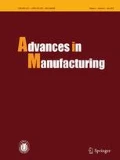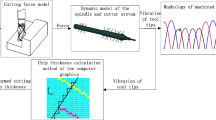Abstract
Geometric physically-based simulation systems can be used for analyzing and optimizing complex milling processes, for example in the automotive or aerospace industry, where the surface quality and process efficiency are limited due to chatter vibrations. Process simulations using tool models based on the constructive solid geometry (CSG) technique allow the analysis of process forces, tool deflections, and surface location errors resulting from five-axis machining operations. However, modeling complex tool shapes and effects like runout is difficult using CSG models due to the increasing complexity of the shape descriptions. Therefore, a point-based method for modeling the rotating tool considering its deflections is presented in this paper. With this method, tools with complex shapes and runout can be simulated in an efficient and flexible way. The new modeling approach is applied to exemplary milling processes and the simulation results are validated based on machining experiments.








Similar content being viewed by others
References
Altintas Y, Kersting P, Biermann D et al (2014) Virtual process systems for part machining operations. CIRP Ann Manuf Technol 63(2):585–605
Denkena B, Böß V, Nespor D et al (2015) Simulation and evaluation of different process strategies in a 5-axis re-contouring process. Procedia CIRP 35(31):31–37
Wiederkehr P, Siebrecht T (2016) Virtual machining: capabilities and challenges of process simulations in the aerospace industry. Procedia Manuf 6:80–87
Arrazola PJ, Özel T, Umbrello D et al (2013) Recent advances in modelling of metal machining processes. CIRP Ann Manuf Technol 62:695–718
Munoa J, Beudaert X, Dombovari Z et al (2016) Chatter suppression techniques in metal cutting. CIRP Ann Manuf Technol 65(2):785–808
Biermann D, Iovkov I (2015) Modelling, simulation and compensation of thermal effects for complex machining processes. Prod Eng 9(4):1–3
Odendahl S, Kersting P (2013) Higher efficiency modeling of surface location errors by using a multi-scale milling simulation. Procedia CIRP 9:18–22
Denkena B, Grove T, Ermisch A et al (2014) New simulation based method for the design of cut-off grinding segments for circular saws. Global Stone Congress, Antalya, Turkey, pp 146–156
Hense R, Baumann J, Siebrecht T et al (2015) Simulation of an active fixture system for preventing workpiece vibrations during milling. In: Proceedings of the 4th international conference on virtual machining process technology, 2015
Martelotti ME (1941) An analysis of milling process. Trans ASME 122:3–11
Kienzle O (1952) Die Bestimmung von Kräften und Leistungen an spanenden Werkzeugen und Werkzeugmaschinen. Z Ver Dtsch Ing 94:299–305
Koenigsberger R, Sabberwal AJP (1961) An investigation into the cutting force pulsations during milling operations. Int J Mach Tool Des Res 1:15–33
Kline WA, DeVor RE, Lindberg JR (1982) The prediction of cutting forces in the end milling with application to cornering cuts. Int J Mach Tool Des Res 22:7–22
Budak E, Altintas Y, Armarego EJA (1996) Prediction of milling force coefficients from orthogonal cutting data. Trans ASME 118:216–224
Kline WA, DeVor RE (1983) The effect of runout on cutting geometry and forces in end milling. Int J Mach Tool Des Res 2–3:123–140
Weinert K, Surmann T, Enk D et al (2007) The effect of runout on the milling tool vibration and surface quality. Prod Eng Res Devel 2:265–270
Merdol DS, Altintas Y (2004) Mechanics and dynamics of serrated cylindrical and tapered end mills. J Manuf Sci Eng 126:317–326
Budak E (2003) An analytical design method for milling cutters with nonconstant pitch to increase stability: part 2. J Manuf Sci Eng 125:35–38
Tunç LT, Özkirimli Ö, Budak E (2015) Generalized cutting force model in multi-axis milling using a new engagement boundary determination approach. Int J Adv Manuf Technol 77:341–355
Fu Z, Yang W, Wang X et al (2015) Analytical simulation of milling: influence of tool design on cutting forces. Procedia CIRP 31:258–263
Engin S, Altıntaş Y (2001) Mechanics and dynamics of general milling cutters, part I—helical end mills. Int J Mach Tools Manuf 41:2213–2231
Foley J, Feiner S, Hughes J (1993) Introduction to computer graphics. Addison-Wesley, Reading, MA, p 559
Weinert K, Surmann T (2003) Geometric simulation of the milling process for free formed surfaces, simulation aided offline process design and optimization in manufacturing sculptured surfaces. Witten 27:21–30
Surmann T, Biermann D, Kehl G (2008) Oscillator model of machine tools for the simulation of self excited vibrations in machining processes. In: Proceedings of the 1st international conference on process machine interactions, Hannover, Germany, pp 23–29
Author information
Authors and Affiliations
Corresponding author
Rights and permissions
About this article
Cite this article
Wiederkehr, P., Siebrecht, T., Baumann, J. et al. Point-based tool representations for modeling complex tool shapes and runout for the simulation of process forces and chatter vibrations. Adv. Manuf. 6, 301–307 (2018). https://doi.org/10.1007/s40436-018-0219-8
Received:
Accepted:
Published:
Issue Date:
DOI: https://doi.org/10.1007/s40436-018-0219-8



